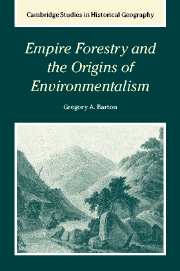Book contents
- Frontmatter
- Contents
- List of illustrations
- Acknowledgments
- 1 Introduction
- 2 The great interference
- 3 Empire forestry and British India
- 4 Environmental innovation in British India
- 5 Empire forestry and the colonies
- 6 Empire forestry and American environmentalism
- 7 From empire forestry to Commonwealth forestry
- Bibliography
- Index
- Cambridge Studies in Historical Geography
4 - Environmental innovation in British India
Published online by Cambridge University Press: 13 July 2009
- Frontmatter
- Contents
- List of illustrations
- Acknowledgments
- 1 Introduction
- 2 The great interference
- 3 Empire forestry and British India
- 4 Environmental innovation in British India
- 5 Empire forestry and the colonies
- 6 Empire forestry and American environmentalism
- 7 From empire forestry to Commonwealth forestry
- Bibliography
- Index
- Cambridge Studies in Historical Geography
Summary
The creation of the Indian Forest Department
Two years after the Forest Charter came the Indian Mutiny, which burst over colonial India in May 1857 and proved the catalyst for both greater deforestation and a militant environmental response. Dalhousie had left India with fair prospects for the colony, declaring that India had been “in peace without and within” with “no quarter from which a formidable war could reasonably be expected at present.” Then quite unexpectedly Indian soldiers rebelled at bullets greased with animal fat. In the colossal effort to put the mutiny down, the British found themselves faced with a dearth of rapid communication – roads, railways, and canals. After the rebellion, railway construction became the priority of Lord Canning, who succeeded Lord Dalhousie as governor-general in 1856.
At the time of the mutiny the beginnings of environmental forestry had been undertaken in Bombay, Madras, and Burma, with Dietrich Brandis setting up a scientific forest administration under the authority of the charter. Also notable for having formed new forestry departments were the Punjab, Oudh, Bengal, and Assam. But when the East India Company found its authority revoked after the mutiny and the double government of crown and company ended, a far more centralized regime emerged, with profound implications for the environment.
In 1864 the governor-general appointed Dietrich Brandis as the first inspector general. Concurrently he also established the Indian Forest Department as an organized state department under the umbrella of the Indian exchequer.
- Type
- Chapter
- Information
- Empire Forestry and the Origins of Environmentalism , pp. 62 - 93Publisher: Cambridge University PressPrint publication year: 2002

